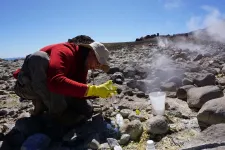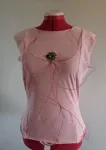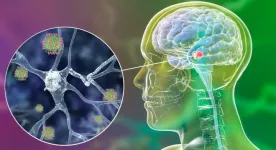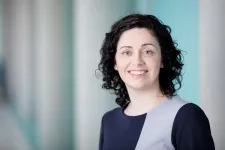(Press-News.org) Crystallization is one of the most fundamental processes found in nature - and it's what gives minerals, gems, metals, and even proteins their structure.
In the past couple of decades, scientists have tried to uncover how natural crystals self-assemble and grow - and their pioneering work has led to some exciting new technologies - from the quantum dots behind colorful QLED TV displays, to peptoids, a protein-mimic that has inspired dozens of biotech breakthroughs.
Now, a research team led by scientists at the Department of Energy's Lawrence Berkeley National Laboratory (Berkeley Lab) and UC Berkeley has developed a nanoparticle composite that grows into 3D crystals. The scientists say that the new material - which they call a 3D PGNP (polymer-grafted nanoparticle) crystal in their recently published Nature Communications study - could lead to new technologies that are 3D-grown rather than 3D-printed.
"We've demonstrated a new lever to turn, so to speak, to grow a crystalline material into a composite or structured material for applications ranging from nanoscale photonics for smart buildings to actuators for robotics," said Ting Xu, senior author of the study. Xu is a faculty senior scientist in Berkeley Lab's Materials Sciences Division and professor of chemistry and materials science and engineering at UC Berkeley.
Xu said that their new method is compatible with the demands of mass manufacturing. "Many smart minds have designed elegant chemistries, such as DNAs and supramolecules, to crystallize nanoparticles. Our system is essentially a blend of nanoparticle and polymers - which are similar to the ingredients people use to make airplane wings or automobile bumpers. But what's even more interesting is that we didn't expect our method to be so simple and so fast," Xu said.
A chance discovery
Lead author Yiwen Qian, a Ph.D. student researcher in the Xu Group at UC Berkeley, discovered the 3D PGNP nanocrystals by chance in an ordinary lab experiment.
A couple of days before, she had left a solution of toluene solvent and gold nanoparticles grafted with polystyrene (Au-PS) in a centrifuge tube on a lab counter. When she looked at the sample under a transmission electron microscope (TEM), she noticed something odd. "Nanoparticles had crystallized quickly. That was not a normal thing to expect," she said.
To investigate, Xu collaborated with Peter Ercius, a staff scientist at Berkeley Lab's Molecular Foundry, and Wolfgang Theis and Alessandra DaSilva of the University of Birmingham, all of whom are widely regarded for their expertise in STEM (scanning transmission electron microscopy) tomography, an electron microscopy technique that uses a highly focused beam of electrons to reconstruct images of a material's 3D structure at high resolution.
Using microscopes at the Molecular Foundry, a world-leading user facility in STEM tomography, the researchers first captured crystalline 3D patterns of the Au-PS nanoparticles.
On the hunt for more clues, Xu and Qian then deployed nuclear magnetic resonance spectroscopy experiments at UC Berkeley, where they discovered that a tiny trace of polyolefin molecules from the centrifuge tube lining had somehow entered the mix. Polyolefins, which include polyethylene and polypropylene, are some of the most ubiquitous plastics in the world.
Qian repeated the experiment, adding more polyolefin to the Au-PS solution - and this time, they got bigger 3D PGNP crystals within minutes.
Xu was surprised. "I thought, 'This shouldn't be happening so fast,'" she recalled. "Crystals of nanoparticles usually take days to grow in the lab."
A boon for industry: growing materials at the nanolevel
Subsequent experiments revealed that as the toluene solvent quickly evaporates at room temperature, the polyolefin additive helps the Au-PS nanoparticles form into 3D PGNP crystals, and to "grow into their favorite crystal structure," said Qian.
In another key experiment, the researchers designed a self-assembling 100-200-nanometer crystalline disc that looks like the base of a pyramid. From this stunning demonstration of mastery over matter at the nanolevel, the researchers learned that the size and shape of the 3D PGNP crystals are driven by the kinetic energy of the polyolefins as they precipitate in the solution.
Altogether, these findings "provide a model for showing how you can control the crystal structure at the single particle level," Xu said, adding that their discovery is exciting because it provides new insight into how crystals form during the early stages of nucleation.
"And that's challenging to do because it's hard to make atoms sit next to each other," Ercius said.
The new approach could grant researchers unprecedented control in fine-tuning electronic and optical devices at the nanolevel (billionths of a meter), Xu said. Such nanoparticle-scale precision, she added, could speed up production and eliminate errors in manufacturing.
Looking ahead, Qian would like to use their new technique to probe the toughness of different crystal structures - and perhaps even make a hexagonal crystal.
Xu plans to use their technique to grow bigger devices such as a transistor or perhaps 3D-print nanoparticles from a mix of materials.
"What can you do with different morphologies? We've shown that it's possible to generate a single-component composite from a mineral and a polymer. It's really exciting. Sometimes you just need to be in the right place at the right time," Xu said.
Co-authors on the paper include Alessandra da Silva and Wolfgang Theis at the University of Birmingham in the United Kingdom; Emmy Yu, an undergraduate student researcher in the Xu Group at UC Berkeley; and Christopher L. Anderson and Yi Liu at Berkeley Lab's Molecular Foundry.
The Molecular Foundry is a DOE Office of Science nanoscience user facility at Berkeley Lab.
The work was supported by the DOE Office of Science.
INFORMATION:
Founded in 1931 on the belief that the biggest scientific challenges are best addressed by teams, Lawrence Berkeley National Laboratory and its scientists have been recognized with 14 Nobel Prizes. Today, Berkeley Lab researchers develop sustainable energy and environmental solutions, create useful new materials, advance the frontiers of computing, and probe the mysteries of life, matter, and the universe. Scientists from around the world rely on the Lab's facilities for their own discovery science. Berkeley Lab is a multiprogram national laboratory, managed by the University of California for the U.S. Department of Energy's Office of Science.
DOE's Office of Science is the single largest supporter of basic research in the physical sciences in the United States, and is working to address some of the most pressing challenges of our time. For more information, please visit energy.gov/science.
The electronic properties of graphene can be specifically modified by stretching the material evenly, say researchers at the University of Basel. These results open the door to the development of new types of electronic components.
Graphene consists of a single layer of carbon atoms arranged in a hexagonal lattice. The material is very flexible and has excellent electronic properties, making it attractive for numerous applications - electronic components in particular.
Researchers led by Professor Christian Schönenberger at the Swiss Nanoscience Institute and the Department of Physics at the University of Basel have now studied how the material's ...
Mineral resources from Chile are of great importance to Germany. According to statistics from the World Bank, thousands of tons of valuable minerals are imported from the South American country every year, including raw materials for lithium-ion batteries. But their extraction causes ecological and social problems: "The use of the limited freshwater resources in northern Chile for mining regularly fuels conflicts with the local population," says Professor Thomas Kohl from KIT's Institute of Applied Geosciences (AGW). "Northern Chile is one of the driest regions on earth, but has extensive geothermal resources. With a novel type of plant, it is not only possible to generate electricity in a climate-friendly way, but also to extract ...
When positioned strategically, garment seams sewn with conductive yarn can be used to accurately track body motion, according to computer scientists at the University of Bath in the UK. Best of all, these charged seams are able to respond to subtle movements that aren't picked up by popular fitness trackers, such as watches and wristbands.
In a new study, the Bath researchers found that clothing made with conductive seams can be analysed to identify the wearer's movements.
PhD student Olivia Ruston, who presented the work at the ACM Designing Interactive Systems conference this month, said: "There are lots of potential applications for conductive yarn in any activity where you want to identify and improve ...
Mice are an important animal model of human vision due to the powerful genetic tools available in this species. However, mouse vision was thought to be different to that of humans because humans have a region of the retina specialized for fine details called the 'fovea' whereas mice do not. Researchers from the Netherlands Institute of Neuroscience (NIN) have shown that the visual cortex of mice does contain a region of enhanced visual sensitivity dubbed the 'focea', making the mouse a better model of human vision than previously expected. The findings were published ...
Lithia, Florida -- June 29, 2021 -- Surgical resident training has traditionally occurred in a master-apprentice-type relationship, with graduated responsibilities until trainees are expected to perform procedures on their own. Given recent changes in the health care system, including reduced operating room time, increased difficulty of procedures and working hour restrictions, there is less time for residents to learn using traditional methods.
Researchers from the University of Manitoba and the Pan Am Clinic recently published a paper in the journal Arthroscopy, Sports Medicine, ...
Aerosol generated by playing woodwind and brass instruments is less than that produced when vocalising (speaking and singing) and is no different than a person breathing, new research has found. The findings, published online in the journal Aerosol Science and Technology, could be crucial to developing a roadmap for lifting COVID-19 restrictions in the performing arts, which have been significantly restricted since the start of the pandemic.
The research project, known as PERFORM (ParticulatE Respiratory Matter to InForm Guidance for the Safe Distancing of PerfOrmeRs in a COVID-19 PandeMic), was supported by Public Health England, the Department for Digital, Culture, Media and Sport (DCMS), and UKRI and was carried out by a collaborative team from ...
The death of neurons specialised in the synthesis of dopamine, one of the brain's main neurotransmissors, deteriorates the motor and cognitive capacities of those with Parkinson's disease. The loss of these neurons is related to alpha-synuclein aggregation. Recent studies show that oligomers, the initial aggregates of this protein, are the most pathogenic forms of α-synuclein and are responsible for the spreading of the disease in the brain.
Therefore, one of the more promising approaches in fighting this disorder consists in neutralising these oligomers and, thus, slow down the pathological progression. ...
During the last twenty years, the trading in stock markets has undergone significant changes. Researchers from the University of Turku and the University of Palermo have investigated the role of high-frequency traders in the markets.
Technological evolution and innovations both in the technology used by stock exchanges and the resources of the traders using their services have made faster trading possible. As a result, high-frequency trading in sub millisecond scale has increased.
However, not everyone has the opportunity to use high-frequency trading, and generally, the scales can be anything from microseconds to tens of thousands of seconds. The role of high-frequency traders has given rise to broad debate over ...
HERSHEY, Pa. -- A new study by researchers at Penn State College of Medicine indicates that people living with human immunodeficiency virus (HIV) and acquired immune deficiency syndrome (AIDS) -- approximately 38 million worldwide -- are more likely to have suicidal thoughts and die from suicide than members of the general population. The researchers said that despite significant medical advancements related to HIV treatment and patients' quality of life, risk of suicide in these patients is high and health care providers should prioritize mental health screenings in this population.
According to the World Health Organization, roughly 800,000 people worldwide die from suicide annually. Among ...
Tuesday, 29 June 2021 - New research has shown that early testing for blood clots in patients who had received the AstraZeneca/Oxford vaccine led to them being treated successfully, highlighting the need for heightened awareness of the risk among doctors.
The work, led by researchers from RCSI University of Medicine and Health Sciences and the National Coagulation Centre at St James's Hospital, is published in the British Journal of Haematology.
Unusual blood clots with low blood platelets have been recognised as a very rare complication of the AstraZeneca vaccine. However, with increased awareness, ...






